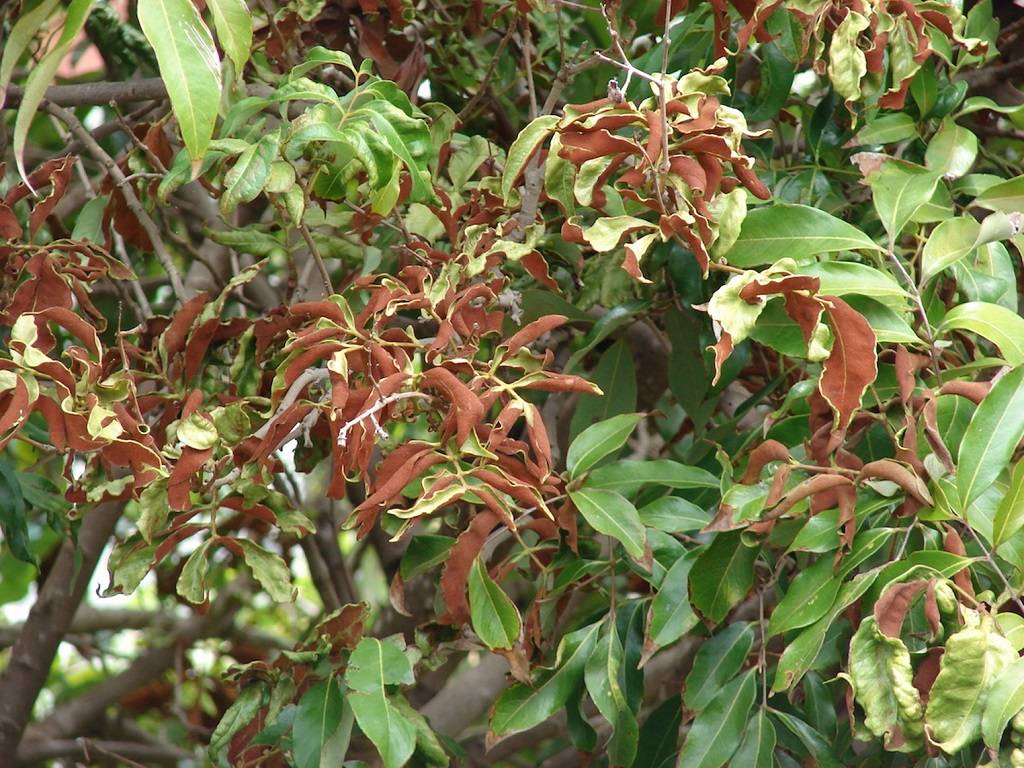
Despite the fact that over 42 insect species and mite pests have been reported to attack litchi trees and fruits at various growth stages, the fruit is still thought to be reasonably pest-free. The main pests that have an impact on litchi productivity include fruit borers, bugs, nut borers, leaf rollers, and mites.
Erinose Mite
A significant pest of litchi is erinose mite. Litchi mite occurrences peak in March and continue through June or July. In Bihar, there has been a severe infestation between March and September, and a population decline between November and February. However, mites continue to be active at certain times throughout the year. It is active on litchi trees from January to October and hibernates in the adult form under the velvety and hairy growth (erineum) on the underside of the leaf from November to December.
Both nymphs and adults damage the leaves, inflorescence, and young developing fruits. They puncture and lacerate the tissues of the leaves with their stout rostrum and suck the cell sap. As a result of its infestation, under surfaces of the infested leaves show abnormal growth of epidermal cells in the form of hair-like velvety growth of chocolate brown color.
Management
-
Only plants that are not infected should be used to prepare layers.
-
When layer saplings leave the nursery, they may be treated with 0.05 percent dimethoate. The procedure should be performed again at intervals of 10–14 days before planting out.
-
The leaves should be checked regularly for symptoms over summer and autumn. It is not to flush or infest all of the trees in an orchard at the same time. As a result, mite-infested branches have to be cut off and burned.
-
After harvesting in June, infested branches must be removed
-
Trees must be treated with 0.05 percent dimethoate, either alone or in combination with 0.12 percent dicofol, in the months of September and October, immediately before vegetative flushing. When new growth is free of all symptoms of infestation, spraying should be repeated two weeks later and then on a monthly basis after that. Infested leaves should be collected, burned, or buried far beneath the surface of the earth.
-
The affected shoots must be cut between December and January, shortly before flush/flower buds, and 0.15 percent kelethane may be sprayed. Two sprays, one before and one after flowering, have been helpful in the month of February.
Bark Eating Caterpillar
The bark-eating caterpillars, which attack trees of all ages, but mainly the elder ones, cause significant harm to litchi, and reduction of their vitality They cut through the trunk, thick branches, and primary stems of litchi trees. They have a wide variety of host plants, including litchi. The old, shady, and abandoned orchards are particularly prone to attack by this insect. When badly infested, the branch or tree may completely die.
Management
-
The caterpillars can be killed by inserting an iron spoke into the tunnels.
-
This insect has also been successfully controlled by injecting kerosene oil into the tunnel using a syringe and then sealing the opening of the tunnel with mud.
-
Another method of control is dipping a small piece of cotton in any of the fumigants, like carbon bisulphide, chlorosal, or even petrol, and introducing it into the tunnel and sealing the opening with clay or mud.
-
Tree trunks should be free of webs, and then each hole should have a 0.05 percent DDVP emulsion before being filled with mud. With a brush, administer a solution of 2 ml chlorpyrifos per liter of water to the region where a bark-eating caterpillar infestation has occurred every 15 days.
-
As a preventive measure, spraying of the attacked trunk and branches with 0.05%DDVP may be done.
Litchi Leaf Roller
From July to February, leaf roller incidents are reported. The number of larvae is the highest from December to February, preceding the flowering season of litchi. When there is a fresh leaf flush, the leaf roller breeds from August to February. Restricted breeding occurs during the off-season (March to July) on alternate hosts other than litchi leaves, such as Kath-Jamun (Eugenia jambolana) and Chhota amaltas (Cassia tora), which grow surrounding litchi orchards. Litchi trees whose foliage is attacked by the larvae have very poor flowering or in the case of a younger tree, no flowering is seen in the season. Thus, the crop yield gets reduced considerably.
Management
-
The damage caused by leaf rollers is tolerated as long as it is restricted to the foliage and unlikely to affect flowers in the Initial Stage.
-
The rolled leaves that contain larvae may be removed manually during light infestations.
-
If required, carbaryl 2g/l can be applied when 20 percent of leaf flushes are infested to minimize damage to young trees or at critical periods of leaf growth in older tree.











